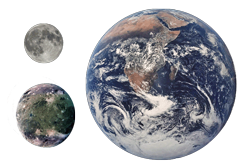The Moon enigma has been a lifetime pursuit since the mid-80's for Doug Ettinger, born in 1944 in Pen Argyl, Pennsylvania. Doug graduated from Lehigh University with a B.S. in mechanical engineering and has retired after a 22-year career in nuclear engineering. He has two sons and currently lives in Pittsburgh, Pennsylvania, with his significant other, Rhonda Smith. Some of his main interests and distractions are snow skiing, hiking, kayaking, sailing, bicycling, tennis, ballroom dancing, movies, and chess.
Doug wrote his initial journals about the Moon enigma. His writings are divided in three hypotheses: Earth's Metamorphosis (EMM) hypothesis (about Earth's collision with a rogue planet and transferring orbits); Collocation of Stars and Planets (CSP) hypothesis (about how planets seek their orbits and stars find binary companions); and Supernovae Seeding (SNS) hypothesis (about how new stars and planets are birthed through the expulsion of supernova ejecta). His passion and self-training crosses many fields of science including astronomy, astrophysics, planetary science, oceanography, physics, geophysics, and particle physics. Hopefully, his depth of knowledge in this wide spectrum of disciplines is adequate to at least meet the minimum of academic standards.
His initial interest started with reading about solar system formation and all the unexplained anomalies that exist. One of these anomalies, the Moon enigma, caught his attention after reading Isaac Asimov's claim that the Moon is actually a planet. Combining the anomaly of the asteroid belt led Doug to consider the ideas for his Earth's Metamorphosis hypothesis.
Doug helped his one son with his science fair project by providing a primitive computer program that could create your own stellar systems or modify the starting conditions of the solar system and then run the program for a given amount of time to determine the end conditions. His son's project was taken to a higher level of competition at a university. The judge explained that his criteria for collisions were invalid because the two-body problem and calculus can prove otherwise. His son did not know how to defend his position by explaining the limitations of the two-body problem. Several months later a comet broke up and crashed into Jupiter for everybody to see. These unfolding scenarios were the seed that finally launched Doug on his way to solve the Moon enigma.
2017 Update
Since posting my original journals and some subsequent editions in 2013, many new developments and ideas have occurred. Also, some power point presentations have been included to aid teachers who wish their students to sometimes think outside the present box of paradigms.
Special attention was given to the Sun's sister star, currently named Nemesis, which at the time, was being hunted by space telescopes. I wanted better reasons for mass extinction events. The accepted notion of a very long period star orbiting the Sun and infrequently disturbing an imaginary Oort Cloud of comets was not believable or proven. NASA has recently revised their model. The disturbances of this star are now considered to be perturbations of the newly discovered Kuiper Belt objects. I slowly and cautiously became convinced that a much closer, very dim brown dwarf star orbited the Sun and intersected the orbits of the Sun's planets, causing occasional chaos. The underpinning of this idea originated with Zecharia Sitchin's book, The Twelfth Planet, that involved a planet with moons that orbited the Sun every 3600 years.
I adapted his idea by making his intruding planet become a brown dwarf star with its own set of planets. This idea easily dovetailed into my postulation of "Earth's Metamorphosis" found in one of my original journals. The Earth's "Great Deluge" is then linked with one of Nemesis's crossings of the inner solar system, which is well dated to be 11,500 years BP, at the end of the Younger Dryas geological period. This led to investigating other crossings at approximate intervals of every 3600 years in my journal "A Brief History of Mankind's Chaotic Past".
Subsequently, I discovered the ideas formulated by a group of independent scientists called the "Electric Universe". Their concepts unbelievably corroborated my journal by indicating an electrified and magnetic brown dwarf star periodically enters our solar system. This star, or its planets, interacts with the Sun's planets, producing scarring and giant pitting through gigantic arc discharges that are readily observable with NASA's space probes. The "Electric Universe" also provides a convincing dialogue, via comparative mythology, that humans witnessed and recorded some of these events.
After taking an Alaskan cruise and talking with the indigenous people, called the Tlingit, I learned that their very distinct tribal cedar dug-out canoe docking systems are found not only at sea level, but at locations 100 to 150 feet above the ocean on the mountain side. The Tlingit flood tradition and this recognition triggered my next journal "The Great Deluge: Fact or Fiction". I combined the ideas of other books written about the Flood, including the exclusion of some of their incongruent arguments. I add the idea that one of Nemesis's planets has a close encounter with Earth that caused many calamities, such as a huge arc discharge that created the Hudson Bay astrobleme and the Noah Flood, which is found in flood traditions throughout the world.
One of the difficulties for the "Electric Universe" group is convincing consensus science that "charge separation" or flow of segregated electrons and electrical current flow through space do exist. This gave me ideas about how these phenomena are possible by establishing the idea of "electron asymmetry" in a journal by the same name. "Electron asymmetry" not only helps to explain "charge separation" and high energy arc discharges between close encounters of celestial bodies, but provides the reason for why gravity exists.


